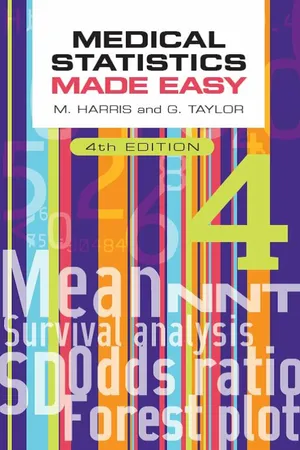
- 140 pages
- English
- ePUB (mobile friendly)
- Available on iOS & Android
Medical Statistics Made Easy, fourth edition
About This Book
Contains all you need to know to understand statistics in medicine. Medical Statistics Made Easy has been a perennial bestseller since the first edition was published (it is consistently a #1 bestseller in medical statistics/biostatistics on Amazon).It is recommended and required worldwide on a variety of courses and programmes, from undergraduate medicine, through to professional medical qualifications.It is a book of key statistics principles for anyone studying or working in medicine and healthcare who needs a basic overview of the subject. It is ideal for non-statisticians who need to understand how statistics are used and applied in medicine and medical research.Using a consistent format, the authors describe the most common statistical methods in turn and then rate them on how difficult they are to understand and how common they are. The worked examples that demonstrate the statistical method in action include current articles from the medical literature and now feature a wider range of medical journals.This fourth edition continues with the same structure as the previous editions, with new sections on cut-off points and ROC curves, as well as a new chapter on choosing the right statistical test. It also features a completely revised and updated 'Statistics at work' section.
Frequently asked questions
Information
Chapter 1
How to use this book
If you want a statistics course
If you are in a hurry
If you are daunted by statistics
If you are taking an exam
TIP!
Test your understanding
Glossary
Study advice
Chapter 2
How this book is designed
“How important is it?”





How easy is it to understand?
Table of contents
- Front Cover
- IFC Pages
- Half Title Page
- Title Page
- Copyright Page
- Contents
- Abbreviations
- Preface
- About the authors
- Ch 1 How to use this book
- Ch 2 How this book is designed
- Ch 3 Percentages
- Ch 4 Mean
- Ch 5 Median
- Ch 6 Mode
- Ch 7 Standard deviation
- Ch 8 Confidence intervals
- Ch 9 P values
- Ch 10 t tests and other parametric tests
- Ch 11 Mann–Whitney and other non-parametric tests
- Ch 12 Chi-squared test
- Ch 13 Risk ratio
- Ch 14 Odds ratio
- Ch 15 Risk reduction and number needed to treat
- Ch 16 Correlation
- Ch 17 Regression
- Ch 18 Survival analysis: life tables and Kaplan–Meier plots
- Ch 19 The Cox regression model
- Ch 20 Sensitivity, specificity and predictive value
- Ch 21 Level of agreement
- Ch 22 Other concepts
- Ch 23 Introduction
- Ch 24 Means, standard deviations, medians and odds ratios
- Ch 25 Confidence intervals and number needed to treat
- Ch 26 Correlation and regression
- Ch 27 Survival analysis
- Ch 28 Sensitivity, specificity and predictive values
- Ch 29 Choosing the right statistical test
- Glossary
- Index
- Back Cover